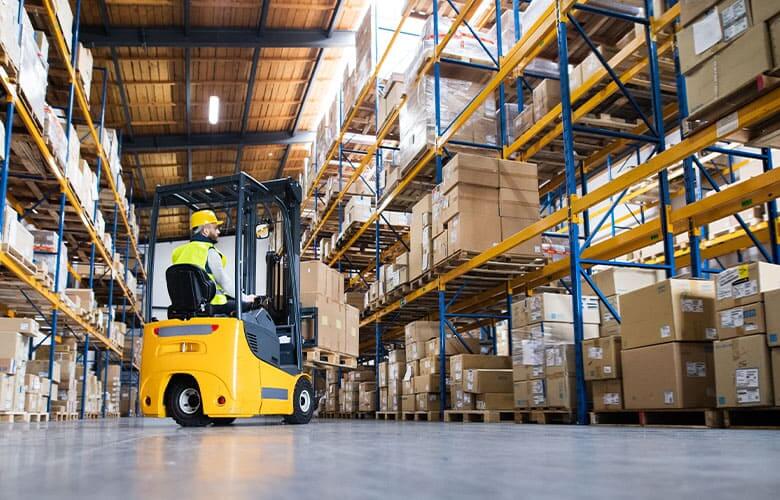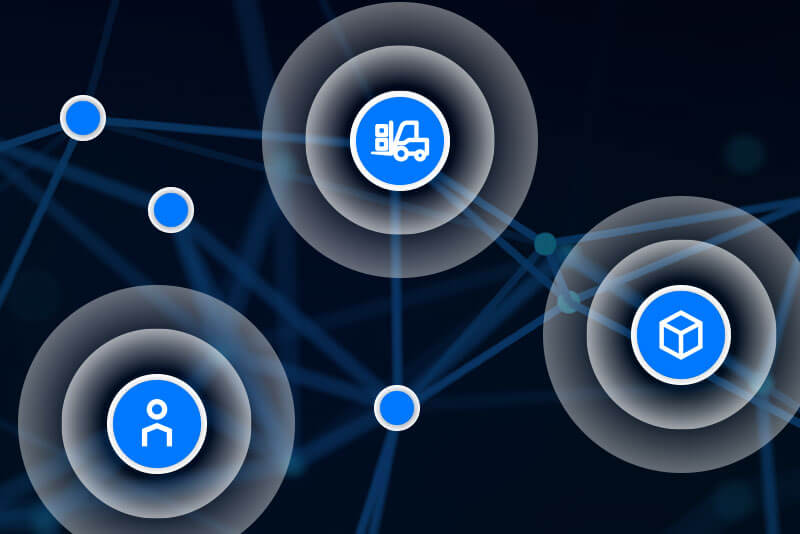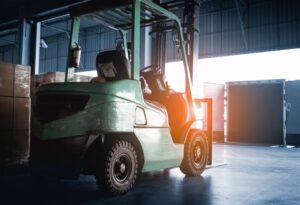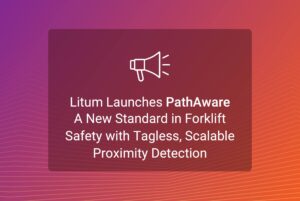Contents
RTLS stands for Real-Time Location System that can locate and track anything, anyone within a defined zone that is covered by radiofrequency.
A well-developed RTLS software program can also be tied into other systems throughout your facility to further improve automation and safety. Here is what we will cover in this article:
What is RTLS (Real-Time Location System) technology?
A Real-Time Location System is an indoor positioning system that locates and tracks anything, anyone within a defined zone that is covered by radiofrequency. is an indoor positioning system that locates and tracks anything, anyone within a defined zone that is covered by radiofrequency.
The real-time location system is this generation’s answer to monitoring the status and movement of assets on the ground. Whether you run a production facility or need to track down forklifts and equipment in a warehouse, it’s likely that an RTLS solutions can help you a great deal.
Companies looking for a better way to monitor their employees and equipment can have it with the utilization of a real-time location system (RTLS).
This unique and innovative technology is rapidly being implemented by many industries around the world. With the ability to track asset and worker movement in real-time using location monitoring equipment and software, companies are able to minimize production slowdowns, identify areas to improve and provide workers with added safety features.
RTLS solutions is a blend of hardware and software that work together to create a mesh network capable of overseeing the movement of RFID tags within a specific location.
This wireless network is created by placing anchors (active RFID readers) at key points throughout and surrounding a facility.
These anchors send out radio signals and also receive radio signals. They can recognize the active RFID tags every time they come within the range of the anchor.
Understanding How RTLS Works
Every RTLS solutions incorporates a combination of hardware and software to create an enclosed indoor positioning network. This meshed system uses several active Radio-Frequency Identification (RFID) readers placed throughout the area to receive the radio signals sent by active RFID tags that are attached to equipment, merchandise, or worn by personnel.
The signal contains vital information about the location and status of each object or person inside the network, which is sent to your servers to be processed by RTLS software.
When the anchors get a signal from an RFID tag, the location of the tag can be calculated by using triangulation, received signal strength (RSSI), time difference of arrival (TDOA), or similar methods. This calculation is done by the location engine, which is a part of the RTLS software.
What are the benefits of RTLS?
Real Time Location System gives companies the ability to track objects and people, while also gathering vital data about these assets and the surrounding environment.
RTLS is great at locations and tracking the movement of “things” via continuous feedback. It can give you information about where an object is at the present, where it has been, and provide an analysis of where it is going.
The RTLS software that Litum has developed serves multiple functions, including:employee
- Displaying where assets are located on the map of the facility
- Showing the movement of assets
- Creating history reports for review
- Triggering alerts and automated actions
The RTLS technology is a vital part of any RTLS solutions. It processes the information provided by the RFID anchors to calculate the location and displays it in an easy-to-understand manner.
RTLS technology can show a map of the work area with a live display of personnel and equipment location. It can even alert designated personnel when an RFID tag leaves the area or is tampered with, which could indicate a potential theft.
Additionally, RTLS technology can provide you with a selection of organized reports using key data received by the RFID readers. These reports can:
- Show any employee tardiness or absences
- Show whether employees move around or remain at their workstation
- Track how many loads each piece of heavy mining equipment moved
- Display completed maintenance on vehicles and equipment
- Display how fast vehicles move and their routes
These are just a few of the many tailored reports comprehensive RTLS software can produce for companies.
Common applications of RTLS Technology
It may be hard to visualize the far-reaching capabilities of real-time location systems before you have a chance to install these technologies in your facility. Litum experts have in-depth experience planning and managing tracking technologies for clients. We have helped businesses utilize RTLS for many applications, as you can see below.
Asset Tracking
One of the most basic functions of the RTLS system is asset tracking to monitor and track the movement of your vehicles, equipment, and tools. With the right technology, you can actively observe vehicles traveling on a tarmac at the airport, find where tools have been left behind by workers in a large facility, and even make sure no equipment leaves a designated area.
Employee Tracking From Long Range
Employee Tracking is also a vital function of a real-time location system. Businesses can use this technology to do virtual roll calls, monitor the active movements of staff members, check that staff is actually working, and even keep track of important data, such as hours worked, tardiness, and which employees used which equipment.
Inventory Management
Tracking merchandise and inventory in a warehouse is another excellent way to utilize RTLS system. With passive and active ID tags, facilities can automatically log the entry of merchandise from the loading dock and keep an accurate count of inventory. This information can also be used to track down points of origin when needed, monitor the production of raw materials, and easily distribute inventory to retailers and other facilities.
Maintenance Management
Sensors installed on ID tags that are affixed to vehicles and equipment can monitor the status of your assets and trigger alerts when maintenance is needed. You can also utilize RTLS to keep track of how often maintenance is needed on various equipment, monitor the results of maintenance, and reduce repair costs from breakdowns.
Environmental & Heat Monitoring
Sensors can also be affixed to passive and active ID tags to monitor the environment, such as gas levels, temperature, humidity, and even vibration that could indicate an earthquake or rock slide. This is a great tool to use in hazardous environments like mining facilities and logging concerns.
Workplace Safety
ID tags worn by employees can also include Man Down alerts that trigger when the employee hasn’t moved for a long period or has even fallen. RTLS can also be used to assist with emergency evacuation, fire training, and collision warning. Real-time location software can actively monitor the movement of vehicles and equipment, such as forklifts, to prevent accidents and crashes. Businesses can also easily enforce social distancing rules within their workplace.
Facility Security
Gateways set up within an RFID network can monitor the passage of personnel to prevent unauthorized access to specific areas. Passive ID tags affixed to tools and equipment may even trigger an alert when someone walks away from the site with these assets. Panic buttons and alarms on ID tags also allow employees to request emergency assistance from security.
What are the types of RTLS Technology?
There is a wide range of technologies developed for use in location tracking systems. Each of these systems offers a selection of unique benefits for businesses. Some technologies are better suited to passive monitoring of assets and personnel as they enter and exit a building. Other systems, such as Ultra-Wideband (UWB) RTLS, are specifically designed to provide accurate, real-time status updates of asset movement within a facility. Before you choose the RTLS technology for your business, take the time to speak with one of our experts about your needs and goals for real-time location tracking.
RFID
Radio Frequency Identification (RFID) solutions are a popular option for facilities and retailers that want to track the movement of merchandise or tools within a short-range. This technology is better suited to passive RFID that tracks tags as they are scanned by handheld scanners or when they pass through gateways.
RFID key points: Low-cost technology; Passive ID tracking; Inventory management, personnel monitoring.
GPS
Open mining operations and other concerns that operate outdoors can benefit from using the Global Positioning System (GPS) to track the movement of their vehicles and equipment. Since this technology uses satellites, it can only provide real-time tracking within a few meters and only outside of buildings.
GPS key points: Medium cost tech; Outdoor satellite, 5 m. location accuracy; asset tracking, monitoring staff; short battery life.
Wi-Fi
A less expensive option for businesses that are just starting to consider real-time tracking, Wi-Fi sends wireless signals in all directions to multiple access points. It is useful for tracking time of arrival time, speed, and has a location accuracy to within 5-10 meters.
Wi-Fi key points: Medium cost tech; 5 m. location accuracy; asset tracking, monitoring staff, facility security and safety.
Bluetooth Low-Energy (BLE)
Bluetooth low-energy beacons (BLE) are becoming more affordable and they offer better location accuracy of within 3-4 m. for real-time tracking. This is also a flexible technology that can be used for tracking objects as they pass gateways or active movement within a facility.
BLE key points: Low-cost tech; 3 m. location accuracy; asset tracking, monitoring staff, facility security and safety.
Ultra-Wideband (UWB)
Ultra-Wideband RTLS technology is one of the most popular options for facilities that require pinpoint accuracy. This low energy frequency provides location accuracy within a sub-meter range. It is ideal for monitoring the movement of fast vehicles and preventing collisions, tracking senior residents, patients, and improving their safety. UWB tags last for years with a single battery and require minimal maintenance.
UWB key points: Premium price tech; sub-meter location accuracy; highly flexible usage, suited to workplace safety and security, asset tracking.
What are the tag types of RTLS?
Since most RTLS hardware is placed within industrial environments, it must offer longevity and complete durability against damage. The RFID tags, in particular, are built to resist everyday damage from falls and impacts of any sort.
A durable shell keeps the electronic components safe, along with very secure fittings and connections within. Some RFID tags are IP 67 rated specifically for outdoor use or use in hazardous environments. These devices have nearly airtight and watertight cases that keep out dust, sand, general dirt, and water.
Some can even be submerged in water for a short period without damage. This is the same for the RTLS anchors, also known as active RFID readers, that are posted throughout a work area. Anchors must also be weather-resistant for outdoor work areas that face wind, rain, and snow.
Depending on how much you are willing to invest in your active RTLS RFID tags, they can come with a range of features that improve personnel safety, prevent damage to equipment, and can provide important data for your employees.
RTLS solutions that utilize state-of-the-art UWB technology provide sub-meter location accuracy when tracking assets, equipment, and employees. UWB RTLS solutions also form their own mesh networks and don’t require network connectivity, which reduces the investment of network infrastructure and cabling.
Some of the features of RTLS RFID tags and readers include:
- Monitoring environment temperature and humidity
- Gas level detection for CO, H2S, NO, O2, and CO2.
- Alert you when assets are overdue for maintenance, repair, or calibration.
- Monitoring the current temperature of motors and other equipment components.
- Alert you if an employee falls down or stops moving for a specific length of time.
- Panic buttons for personnel to press if they need help.
- Track the speed and fuel usage of equipment or vehicles
- Keep track of inventory levels in a warehouse, facility, or store.
Which industries can use RTLS technology?
Sometimes, it is difficult for a company to fully realize the capabilities of RTLS solutions and just how these systems can solve the everyday challenges that come with operating a business. This technology has applications in many areas of business and industry.
When you need to streamline your production process, improve on-the-job safety, and minimize inventory losses, an RTLS is an answer.
RTLS for Aviation
RTLS solutions in aviation enhance ground operations by tracking aircraft parts, tools, and equipment in real-time. UWB and RFID systems reduce maintenance delays and improve turnaround time by helping technicians locate tools and parts efficiently. Furthermore, RTLS aids in monitoring personnel movement on runways, enhancing safety in high-traffic zones.
RTLS for Construction
RTLS improves productivity and safety on construction sites by providing real-time tracking of equipment, tools, and workers. It helps reduce theft, monitor the usage of heavy machinery, and improve compliance with safety protocols. Workers carrying RTLS-enabled tags can also receive alerts to avoid hazardous areas, preventing accidents in dynamic environments.
RTLS for Education
In educational institutions, RTLS ensures student and staff safety by tracking their location on campus. It helps monitor access to restricted areas and provides real-time alerts for emergencies. RTLS also streamlines attendance tracking, simplifying administrative processes by automating student presence logging during events or classes.
RTLS for Energy
The energy industry leverages RTLS for asset management, worker safety, and workflow optimization in hazardous environments like oil rigs and power plants. Real-time tracking ensures quick evacuation during emergencies and prevents unauthorized entry into restricted areas. By monitoring equipment usage, RTLS also supports predictive maintenance to minimize downtime.
RTLS for Healthcare
In healthcare, RTLS plays a critical role by tracking medical equipment, staff, and patients. It ensures the availability of critical devices and optimizes workflows by providing real-time visibility into staff movements. Additionally, RTLS supports patient safety by reducing wait times and providing location-based alerts for emergencies, such as infant abduction prevention.
RTLS for Manufacturing
RTLS in manufacturing enhances operations by tracking materials, tools, and work-in-progress (WIP) components. It helps reduce downtime by preventing production delays caused by misplaced items. With real-time visibility into the manufacturing floor, managers can identify bottlenecks and allocate resources efficiently to improve productivity.
RTLS for Supply Chain and Logistics
In supply chain and logistics, RTLS provides real-time visibility of goods and assets, improving inventory management and reducing shipment delays. It enables precise tracking of vehicles and containers across facilities, minimizing search time and ensuring timely deliveries. RTLS also enhances warehouse safety by preventing collisions and optimizing dock operations.

RTLS for Companies at the Busy Warehouse
Warehouses are constantly moving inventory in and out of a facility, not to mention dealing with the delivery vehicles that can arrive every few minutes.
Litum’s expert technicians can install an indoor positioning network within the warehouse and at the gates to your shipping and receiving areas. We’ll also provide durable RFID tags that can be attached to cherry pickers, forklifts, and even delivery trucks. All of which provide real-time updates as to where the equipment is and what it’s doing.
The RTLS software displays this information at the touch of a button and can send a text alert to designated personnel when equipment overheats, the operator drives too fast, or if there is an accident.
If you would like to track inventory movement, Litum can help too. In that case, printable passive RFID tags can be affixed to pallets and product packaging that pings off of readers as they are moved to and from the shipping and receiving areas.
This provides information that our software uses to update the inventory levels within your warehouse, provide dates and times for when items arrived or left, and even provides location instructions to forklift operators for drop-off or pick-up.
RTLS & RFID on the production line
Thanks to the development of Industry 4.0 technology, you can use RTLS solutions and RFID technology in conjunction to decentralize your production line.
It is also possible to implement easy to apply passive RFID tags to components in your final product. As each component moves down the line an RFID reader within your equipment scans this tag, which directs the machine or prompts the operator to complete the next step in the item’s construction.
The RFID software is designed to monitor production speed, inventory, and alert you to any slowdowns to help you keep an eye on the entire process. Facility managers are even able to estimate completion times for production quotas and deal with slowdowns or maintenance when alerted.
In the underground and open mines
Working deep below the earth or in a stone quarry where dynamite blasts occur makes mining a very hazardous process. With an RTLS in place, you can improve personnel safety and production at the same time.
Litum active RFID tags provide real-time updates as to the speed and location of each vehicle or piece of equipment in operation. The system can also track how much raw material is moved based on the number of loads that pass by readers at specific points.
RFID tags worn by personnel can also provide real-time updates of their location, movement, and even feature a man-down system in case a worker is injured and stops moving. In this case, the system would alert designated personnel that a worker has not moved within a certain length of time. You can then look up where that worker’s RFID tag is on the computer display and dispatch help.
Our RTLS software is adaptable and can monitor and reduce vehicle speed to safe levels, stop vehicles if they are about to collide and restrict the usage of certain equipment to trained personnel.
RTLS can be used in many other sectors. Below, you can find some useful articles about its use in different sectors.
The Future of RTLS Market
According to Research and Markets, the global RTLS market is expected to grow a whopping 22.5% by 2023. This technology is being rapidly adopted by companies in the healthcare, retail, manufacturing, and automotive sectors. With an increasing need to meet stricter government regulations and remain competitive in an economy bursting with startups, it’s no wonder that so many businesses are adopting real-time tracking systems.
Among the commonly used RTLS technology, UWB is expected to grow the fastest in the coming years. This system is capable of tracking a large number of tags at once to the greatest level of accuracy. It should also be noted that the prices for UWB-capable tags are dropping, which makes this system more and more affordable by the day.
If you are thinking about updating your production processes with new technology, contact Litum. We help you design and set up the ideal RTLS for your company’s needs. Our locally based experts will also meet with you in person to go over the options right away.




